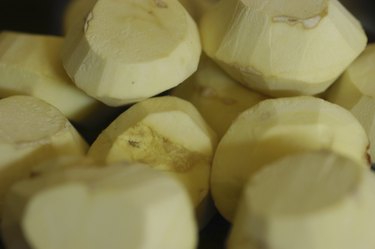Things You'll Need
Large bowl
Water
Citrus fruit

While it is a time-saver to prep meals for the next day the night before, it can be problematic if you are peeling and cutting up certain types of vegetables. Many root vegetables, such as potatoes and celery roots, and others like artichokes start to brown almost immediately when the flesh is cut and exposed to air, due to an enzyme they carry. These vegetables become unattractively and progressively brown if you leave them on the counter overnight. Take preventative steps to preserve your vegetables and keep them looking fresh until you're ready to cook with them.
Step 1
Place peeled vegetables in a bowl of cold water immediately. The cold water helps to slow down the browning process.
Video of the Day
Step 2
Add acid to the bowl of cold water. The ascorbic acid found in citrus fruits like lemons and limes further slows down the browning process, without altering the taste of the vegetables. As an alternative to citrus fruits, you can purchase store-bought ascorbic acid at most grocery stores.
Step 3
Store the bowl in the refrigerator. The refrigerator keeps the water and the temperature of the peeled vegetables low, which keeps the browning process at bay.
Tip
Use the peeled vegetables as soon as you can the next day. The preventative measures only slow down the browning process.
If the vegetables have begun to brown, you may only have to slice off the exposed outer layer and still use the rest.
Warning
Avoid using knifes that have any corrosion on them to peel and cut up vegetables, as this will cause them to brown faster. Use a clean and very sharp knife when peeling and cutting vegetables, which minimizes the bruising that encourages browning.
Video of the Day